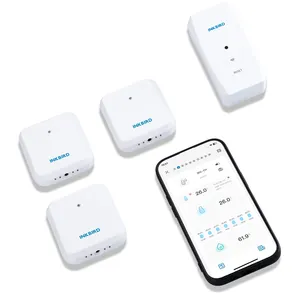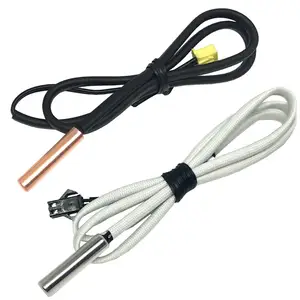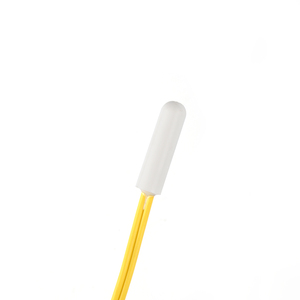(8283 products available)

























































































































































































AC temperature sensors are a vital part of AC systems. They are designed to monitor and regulate air, refrigerant, and room temperatures.
The room air conditioner temperature sensor is mounted on the wall. It is generally placed in a central location. These sensors are designed to measure the average temperature of a room or the entire house. The data obtained from these sensors help the AC controller to regulate the temperature of the air conditioner.
Duct sensors are placed inside the ventilation ducts. They measure the temperature of the air flowing through the ducts. This allows for the monitoring and regulation of the temperature of the air conditioner. The placement of the air con sensor inside the ducts helps in ensuring accurate temperature control since it is not influenced by external factors.
Indoor and outdoor sensors are designed to monitor outdoor temperature and humidity levels. This helps the air conditioner to adjust its operations according to the weather conditions. For instance, during hot weather, the air conditioner can increase its cooling capacity based on the data obtained from the outdoor temperature sensors, and vice versa.
Liquid AC air sensors are designed to monitor the temperature of the liquid refrigerant in the AC system. They are placed in the inlet and outlet points of the air conditioner to monitor the temperature of the refrigerant. The data obtained is used to diagnose problems related to the air conditioner's cooling system.
Discharge air sensors are placed in the air outlet of the air conditioner. They are designed to monitor the temperature of the air being discharged from the air conditioner. This allows for the measurement of the cooling performance of the air conditioner. Also, the data obtained is used to detect any problem in the cooling system of the air conditioner.
Room and coil temperature sensors are designed to measure the temperature of the room and the AC coil. The data obtained from the sensors is used by the air conditioner to adjust its settings and ensure optimal temperature control.
Wireless air conditioner sensors are connected to the air conditioner using wireless technology. The sensors communicate with the air conditioner's control unit using infrared, Wi-Fi, or Bluetooth. The advantage of wireless sensors is that they are easy to install and can be placed in different locations within the home.
Temperature sensors have specific specifications and need proper maintenance to function effectively. Here are the specifications of an air conditioner temperature sensor.
The temperature sensor can measure a specific temperature range. This is an important specification, especially for air conditioners, since it helps users understand what the sensor can be used for. Some sensors can measure -40 to 60 degrees Celsius, while others may measure 0 to 100 degrees Celsius. The temperature range enables the sensor to suit various applications, such as monitoring the temperature in fridges, freezers, and air conditioners.
Users should also be aware that temperature sensors have different temperature ranges, and not all are the same. The measurement data may be inaccurate if used beyond the specified temperature range.
These sensors have a specific measurement accuracy. This is the difference between the measured value and the true value. To ensure the accuracy of the sensor, the error should be within the specified range. The measurement accuracy is usually given in the instruction manual. For example, the temperature sensor may have an accuracy of ±0.5°C.
Temperature sensors use electricity to operate. They need a specific voltage to function properly. The power supply voltage specification is important. Suppliers may provide this information in the product specifications. For example, the temperature sensor may have a voltage of 3 to 5 volts.
The temperature sensor can send a signal to a temperature controller. It has a specific signal type, such as analog or digital. It also has a specific signal type, such as 4-20mA or 0-5V.
The response time of a temperature sensor is the time it takes to measure temperature changes. It is measured in seconds. Some sensors have a faster response time than others. A faster response time is preferred since it allows the sensor to detect temperature changes quickly.
The sensor can be protected from environmental factors such as dust and moisture. It has a specific protection level. For example, the sensor may be waterproof or dustproof. This helps the sensor last longer.
The temperature sensor can be installed in a specific way. It has mounting holes or brackets. This helps users know how to install the sensor properly. For example, the sensor may be mounted on a duct using a bracket.
There are many ways to maintain a temperature sensor. Here are a few of them:
Users can compare the sensor's temperature readings to a reference temperature. A thermometer can be used as a reference temperature. If the readings are different, users can adjust the sensor to match the reference temperature.
Temperature sensors can pick up dirt and dust over time. This can cause inaccurate temperature readings. Users should clean the sensors regularly using a soft, dry cloth.
Users should not drop the temperature sensor or hit it against hard surfaces. This can damage the internal components and affect the accuracy of the sensor.
Users should not expose the temperature sensor to high temperatures since this can cause damage. The sensor should be stored in a cool, dry place when not in use.
When choosing an air conditioner temperature sensor, business buyers should consider the temperature range. They should know the maximum and minimum temperature limits of the sensor. Select a sensor that can perform effectively in the temperature range of the AC system.
To choose the right air conditioner temperature sensor, business buyers should consider its accuracy. They should select temperature sensors that provide accurate readings for their intended applications. They can check the accuracy level of the sensors in the product specifications. Also, they can read customer reviews to know the accuracy of the sensor in real-life situations.
It's essential to consider the response time when choosing an AC air sensor. Business buyers should select sensors with a fast response time. The sensors can provide real-time temperature changes in the environment. They are suitable for applications where instant temperature changes are needed.
Business buyers should consider whether the air conditioner temperature sensor is pre-calibrated. Pre-calibrated sensors come with a calibration certificate. The certificate ensures the sensors provide accurate readings. If the sensor is not calibrated, they should calibrate it using the manufacturer's guidelines.
When choosing an air conditioner temperature sensor, business buyers should consider its power requirements. They should select sensors that are compatible with the power supply of the AC unit. Also, they should choose low-power sensors to reduce power costs.
Business buyers should consider the wiring and installation of air conditioner temperature sensors. They should select sensors with easy-to-install features. Also, they should choose sensors that come with a user manual to guide them on the proper installation process.
It's essential to consider sensor compatibility when choosing an air conditioner temperature sensor. Business buyers should select sensors that are compatible with the AC control system. They should consult the sensor supplier to check the compatibility of the sensor. Also, they can read the customer reviews to know the compatibility of the sensor.
When choosing an air conditioner temperature sensor, business buyers should consider the environmental conditions. They should select sensors that can perform effectively in extreme environmental conditions. Also, they should choose sensors with an IP rating to protect them from dust and water.
Business buyers should have a budget when choosing an air conditioner temperature sensor. They should compare the cost of sensors from different suppliers to get the best deal. Also, they should not choose cheap sensors as they may be less accurate.
Replacing an AC temperature sensor can be an easy DIY project. However, it requires time and patience. Follow these steps to replace a faulty temperature sensor:
Get the right tools for the job and wear protective gear. Turn off the power supply to the AC unit before starting the replacement.
Find the sensor. Typically, it is located close to the evaporator coil. It may be inside the unit or in the room where the thermostat is mounted.
Take out the sensor. Depending on the type of sensor, it may be clipped, screwed, or plugged. Gently remove it from its position without damaging any part of the unit.
Connect the new sensor to the wires. Make sure the wires are properly insulated. Put the sensor back in its position and secure it with clips, screws, or plugs.
Before closing up, turn on the power supply and set the thermostat to a temperature that will make the AC unit run. Check to see if the unit cools as it should. If it doesn't, switch it off, unplug it, and recheck the connections. If the problem persists, reach out to a professional for assistance.
Q1. What is the function of an air conditioner temperature sensor?
A1. The air conditioner temperature sensor plays a vital role in the air conditioning system by monitoring the temperature and adjusting the cooling to achieve the desired room temperature. It ensures energy efficiency and prevents the air conditioner from overworking.
Q2. Where is the temperature sensor located on the air conditioner?
A2. The temperature sensor is located in different parts of the air conditioner, depending on the type of AC. In split AC, the temperature sensor is placed on the indoor unit. For window AC, the temperature sensor is located on the AC's front grill. It can also be on the control panel of the air conditioner.
Q3. Can one repair the air conditioner temperature sensor?
A3. It is not recommended to repair or tamper with the air conditioner temperature sensor. If it is faulty or damaged, it is advisable to contact a professional HVAC technician for repair or replacement?
Q4. How can one ensure the temperature sensor functions properly?
A4. The best way to ensure the temperature sensor functions properly is to keep the area around the temperature sensor clean and unobstructed. Also, ensure cool air from the air conditioner does not blow directly on the sensor.